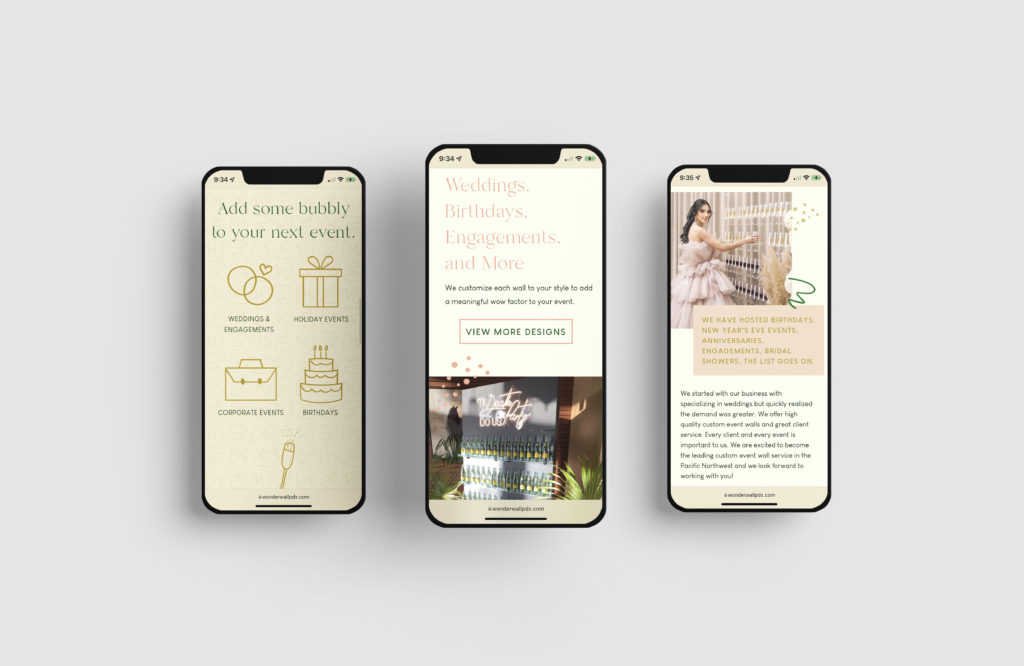Showit vs Squarespace isn’t just a tech debate, it’s a decision that impacts how easily you can update your website, how much design freedom you have, and ultimately how your clients experience your brand online. For creative business owners and wedding pros, your website isn’t just a portfolio. It’s your storefront, your booking hub, and often the very first impression someone has of your work.
In this episode of Engage Your Brand™, I break down Showit vs Squarespace with a fresh 2026 perspective. We’ll look at what’s changed, what’s stayed the same, and how to decide which platform best fits your business goals.
Prefer to listen?
Tune in on Spotify, Apple Podcasts, or listen right here.
Website platform breakdown: Showit vs Squarespace
I talk about Showit vs Squarespace with clients all the time, and it’s still one of the toughest breakdowns in 2026. If you’re a wedding business or creative service provider building a website yourself or working with a designer, you’ve likely considered these two platforms. Both are popular, powerful, and user-friendly but they have key differences that matter for your business.

At Emily Foster Creative, we design for:
- Photographers & videographers
- Wedding planners & venues
- Rental companies & florists
- Calligraphers & officiants
- Coaches, therapists & nutritionists
- Copywriters, marketing agencies & social media managers
This blog (and the podcast episode) focuses on these industries. If you’re running a large e-commerce business, you may need a different platform altogether.
Showit vs Squarespace compared to other platforms
Both platforms are part of a bigger ecosystem. Alongside Showit and Squarespace, many wedding pros and creatives also consider:
- Wix (check out my Showit vs Wix blog here)
- WordPress (with builders like Elementor or Divi)
- Webflow (gaining popularity with advanced users)
- Shopify (best for full e-commerce)
👉 But in my daily conversations, the real head-to-head is still Squarespace vs Showit.
Why “ease of updating” matters
On the podcast, I shared how July and August of last year reminded me of an important truth: we all need systems that allow us to step back. Whether it’s batching emails, social posts, or podcasts, it’s the same with your website.
Your platform should let you:
- Swap photos or update text quickly
- Add new services without calling a developer
- Adjust SEO details on your own
Your site is too important to rely on someone else for every update. That’s why the Showit vs Squarespace question is really about long-term sustainability.
Website templates: who does it better?
Because of Showit’s flexibility (without needing custom code), most Showit templates feel more intuitive and customizable.
- In Squarespace, basic sections like Instagram grids often require at least light coding.
- During a client VIP Day, I customized a Squarespace template and realized how hard it would be for her to update alone.
- Showit templates, by contrast, allow drag-and-drop adjustments without code.
👉 If you’re starting out, a Showit template can give you a professional, flexible design without coding headaches.
Coding: the biggest difference
I’ve used both platforms for my own sites and client projects, and here’s the truth:
- Squarespace: You’ll eventually need light code for anchors, mobile menus, or styling headlines.
- Showit: You can do more without touching code.
Over the last year, Showit has rolled out:
- A true “button” feature (no more layering text boxes)
- Clearer alt text fields for SEO
- Ongoing improvements driven by designer feedback
For about 95% of my clients, avoiding code is a top priority. That’s why I often recommend Showit for creative businesses.
7 things you can do in Showit without code (that often require coding in Squarespace)
1. Putting text directly over a gallery.
A lot of photographers love to have a stunning hero section with a logo or tagline layered over the gallery. This creates a nice, elegant intro to a page. For this example of K.S. Gray Photography’s website, we designed his website in Showit. He was already on the platform anyway, but Showit’s design flexibility allowed us to layer words over images.
This isn’t always a preference for photographers, but when it is, it’s very nice to be able to do this without needing coding!
2. Anchoring a button to somewhere further down in the page.
Let’s say that you have an About page and at the top of the page, you want to have a button that links to a section further down the page for Frequently Asked Questions. It’s a great way to limit your page count overall, but still keep your website easy and quick to navigate.
We use this feature for our Showit clients a lot, and for my last Squarespace client, I had to use some basic code to do the same thing.
3. Adjusting the width of the top navigation to exactly what you want it to be.
We love creating custom navigation for our clients, and it’s extensively more limited in Squarespace when you don’t want to use coding.
If you’re looking for a really unique website top navigation or footer, Showit may be a better choice for you to allow for that flexibility.
4. Creating a testimonial carousel with custom font sizes and colors.
Many of our clients have 10+ testimonials that they want to include from clients. It’s great to have a variety of design options for these, because making them stand out is everything!
5. Updating the color of a line.
I know this sounds super basic and like something you should be able to do in any platform. But as of January 2024, you can’t do this in Squarespace without a little code. That’s totally ok for some people, as you can upload a line as an image, use code, or find another design alternative. But, it’s something small to keep in mind if you want lots and lots of design flexibility with your website platform.
6. Updating the size of text on a mobile menu.
This is a big irk for me, as creating a customized mobile menu for clients is a great aesthetic add. You can update the text size on a mobile menu in Squarespace to a certain extent, but at some point, you’ll run into needing to use a little code.
7. Updating the specific size of just one H1, H2, or H3 headline.
For all of our clients, we add heading tags to your website so that you have just one H1 on each page, a few H2 headlines, and a few H3 headlines. This exact breakdown depends on your copywriting and SEO goals, but adding heading tags is an important detail for your on-page SEO.
In both Squarespace and Showit, you can apply heading tags fairly easily. However, in Showit you can tag any line as a heading tag, whereas in Squarespace your H1 is set to one style, your H2 is set to another style, and your H3 headlines are set to another, separate style. If you wish to change the style of one H1 heading, you’re going to have to change it on allll the H1 headings on your site, unless you want to use some coding.

Ease of Transition: Real Experiences
Switching website platforms is never “one click and done.” From my own journey (Squarespace → Wix → Showit) and from client projects, here’s what to expect:
- Squarespace → Showit: Showit will migrate your blogs if you’re on the Advanced Blog plan. Expect a 3–5 day wait and some manual cleanup (categories, featured images).
- Wix → Showit: More tedious, since blogs must be transferred manually.
- Pro tip: Temporarily turn off two-factor authentication in Squarespace during migration. It makes the process smoother for Showit’s team.
- Always allow buffer time: Give yourself 7–10 days between final design approval and your official launch date. That cushion prevents last-minute stress.
10 more pros and cons in 2026
Here’s how the platforms compare today:
1. Ease of use → toss-up
- Squarespace is structured, drag-and-drop, clean, and beginner-friendly.
- Showit feels more like Canva: freeing for creatives, overwhelming for some.
2. Design flexibility → Showit wins
- Customize every pixel.
- Mobile and desktop can be designed side by side.
- Squarespace’s Fluid Engine is better than past versions but still has limits.
3. Mobile responsiveness → Showit wins
- Full customization for mobile.
- Squarespace stacks mobile automatically (faster, but harder to fine-tune).
4. Pricing → tie
- Squarespace: starts at ~$16/month (billed annually).
- Showit: common plans $24–$29/month.
- Both average <$500/year, a small expense compared to the return on a well-built site.
5. E-commerce → Squarespace wins (for small shops)
- Built-in shopping features.
- Showit requires third-party integration (Shopify Lite, Thrivecart, WooCommerce).
- For 30+ products? Skip both → go Shopify.
6. SEO → tie
- Both allow page titles, meta descriptions, and alt text.
- Showit’s WordPress integration + Yoast plugin gives extra power.
- Squarespace SEO tools are solid but less customizable without code.
7. Blogging → Showit wins
- Designed in Showit, written in WordPress.
- WordPress + Yoast = strong SEO optimization.
- Squarespace blogs work but can feel boxy without code.
8. Support → Showit wins (slightly)
- Squarespace has more resources, but slower, less personal responses.
- Showit has responsive chat (added AI assistant in late 2024, but still highly personal).
- In my experience, Showit’s support is quicker and more hands-on.
9. Integrations → Squarespace wins
- Broad range of built-in integrations (email, courses, payments).
- Showit integrates less, though most creatives don’t need advanced systems.
10. Community → Showit wins
- Designer feedback directly influences Showit updates.
- Squarespace has Circle Day in NYC.
- Showit has Spark (formerly United) in Phoenix, AZ, plus an active designer/copywriter network.

Which Platform Fits Your Business Stage?
Here’s how I guide clients based on where they are:
- New businesses → Squarespace can be quicker to set up and easier to manage when you’re just starting out.
- Scaling creatives → Showit gives you more branding freedom and flexibility as your services grow.
- Established businesses with e-commerce → Shopify is worth considering if selling products is your primary income stream.
Hidden Costs to Consider
Subscription pricing isn’t the only factor:
- Squarespace → Budget for light coding or occasional developer help if you want advanced styling.
- Showit → Migration support is included, but you may need extra VA/designer time for blog cleanup after transfer.
- Both → Factor in your time investment. Even with a template, expect hours of customization.
These hidden costs aren’t deal-breakers—but knowing them upfront helps you plan smarter for your website launch.
Transition considerations in 2026
If you’re thinking of switching platforms:
- Always allow buffer time: Give yourself at least 7–10 days between “final design” and launch.
- Squarespace → Showit: Showit will migrate your blogs (with the Advanced Blog plan). Expect 3–5 days + some manual cleanup of categories/images.
- Wix → Showit: Blogs must be transferred manually.
- Pro tip: Turn off two-factor authentication in Squarespace before migration to avoid hiccups.
Squarespace vs Showit in 2026: Future-Proofing
When choosing a platform, don’t just think about today. Think 2–3 years ahead:
- Showit is steadily growing with updates based on user feedback. Its focus remains on flexibility, community, and design freedom.
- Squarespace continues expanding e-commerce and integrations, making it a solid all-in-one hub.
- Both platforms will evolve, but the right choice depends on whether you want structure (Squarespace) or freedom (Showit).
So… Squarespace vs Showit: which should you choose?
Choose Squarespace if you want:
- Quick, structured setup
- Built-in e-commerce for a small shop
- An easy, guided editor
Choose Showit if you want:
- A fully customized, high-end look without code
- More mobile and design flexibility
- Stronger creative community and responsive support
My 2026 verdict
Squarespace and Showit both remain strong platforms. Squarespace is great for beginners and small shops, but for most wedding professionals and creative service providers, I recommend Showit for its:
- Design freedom
- Mobile customization
- Blogging power with WordPress
- Supportive community
Ready to go deeper?
This blog scratches the surface. For more details, real client stories, and up-to-date insights, listen to my full podcast episode on Showit vs Squarespace.
🎧 Listen on Spotify | Apple Podcasts | or here.
And if you’re ready to make your next move:
- Browse our Showit templates for a DIY start.
- Book a free consultation call for tailored advice.
- Explore our portfolio to see what’s possible on both platforms.
Your website should be a tool that grows with you, not something that holds you back. The right platform will make updating, marketing, and booking easier well into 2026 and beyond.
Leave a Reply Cancel reply
We respect your privacy.
Copyright Emily Foster Creative, LLC. 2021 - 2025. All rights reserved.
hello@emilyfostercreative.com
Brand photography by Lena Crocker Photo, Ciara Corin Photo, Moon & Honey Photography and Enliven Photography
Powered by podcasts and tea.
Designing out of Portland, Oregon for creatives around the world.

Be the first to comment